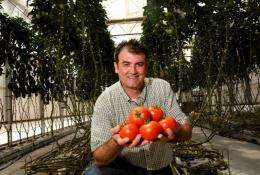September 16, 2010 report
Researchers build Moon garden

The Moon is not the most hospitable place for growing fruits and vegetables. The lack of atmosphere and natural water, extreme temperatures, and exposure to cosmic rays present some serious challenges for future inhabitants who want to pursue sustainable living on the Moon. With these challenges in mind, scientists have built a lunar greenhouse that is designed to grow plants such as potatoes, peanuts, tomatoes, and peppers under the Moon's extreme conditions.
Developed by Phil Sadler of the Sadler Machine Co. and Gene Giacomelli and other researchers at the University of Arizona, the 18-foot-long greenhouse would be buried underneath the Moon's surface to avoid deadly cosmic rays and solar flares. Plants can grow without soil in the greenhouse thanks to hydroponic technology, mineral nutrient solutions, and long envelopes that hold the seeds in place as they start growing.
The greenhouse is designed so that the plants can get carbon dioxide from the astronauts' exhaled breaths. Furthermore, even the water for the plants can be extracted from human urine. The astronauts wouldn't need to go underground to deliver these ingredients to the plants; instead, the carbon dioxide and water would be supplied into the underground greenhouse from a surface lunar base through pressurized tanks. Similarly, sunlight could be supplied to the plants through fiber optic cables.
The researchers designed the greenhouse to operate remotely or even autonomously, so that food could be ready when astronauts arrive. The entire system can be collapsed into a four-foot-wide disk, sent to the Moon, and deployed in 10 minutes. With the option of being monitored from Earth by sensors and cameras, it will then take about 30 days for the vegetables to grow.
"You can think of this as a robotic mechanism that is providing food, oxygen and fresh drinking water,” Giacomelli said in a press release.
Overall, the lunar greenhouse contains approximately 220 pounds of wet plant material that can provide 53 quarts of potable water and 0.75 pounds of oxygen during a 24-hour period, while consuming about 100 kilowatts of electricity and a pound of carbon dioxide.
Many of the garden's features come from the South Pole Growth Chamber here on Earth, which was previously designed by the Sadler Machine Co. The growth chamber has to overcome some of the same challenges for certain months of the year when the circulating ocean currents cut the pole off from the rest of the world. The researchers are also looking at using similar technology for use in urban gardens in heavily populated areas, where fertile soil is scarce.
"There's great interest in providing locally grown, fresh food in cities, for growing food right where masses of people are living," Giacomelli said. "It's the idea of growing high-quality fresh food that only has to be transported very short distances. There also would be a sense of agriculture returning to the everyday lives of urban dwellers."
More information:
University of Arizona's Controlled Environment Agriculture Center
via: UANews
© 2010 PhysOrg.com

















